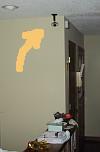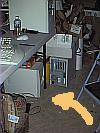How LivingRoomCam Works
LivingRoomCam's setup is a hodge-podge that has grown up over the years.
One of the effects of having grown up over the years is that most of the
cameras are different and all of the cameras are connected differently.
I've been trying different methods of capturing images weighing
the problems of wiring and price.
So, I'll cover each of the cameras separately.
 Kitchen.
The kitchen is the "cleanest" camera implementation so it should
come first.
I'm using an
Axis 2100 Network Camera
from
Axis Communications
.
I have two total (the other one is in the livingroom).
You plug the camera into the network and it serves up JPEG
images. No muss, no fuss.
Kitchen.
The kitchen is the "cleanest" camera implementation so it should
come first.
I'm using an
Axis 2100 Network Camera
from
Axis Communications
.
I have two total (the other one is in the livingroom).
You plug the camera into the network and it serves up JPEG
images. No muss, no fuss.
The kitchen camera is installed on the ceiling and I crawled
around in the attic to run the network and power cables down
to the basement where the network hub is.
 Living Room
The living room is another Axis 2100 camera but, rather than
running cables around the house for networking, I'm using a
WET11 Wireless Eternet Bridge
from
Linksys.
The bridge just extends the ethernet connection from the
house. The access point is a
WAP11 Wireless Network Access Point
that's in a closet in the middle of the house.
Living Room
The living room is another Axis 2100 camera but, rather than
running cables around the house for networking, I'm using a
WET11 Wireless Eternet Bridge
from
Linksys.
The bridge just extends the ethernet connection from the
house. The access point is a
WAP11 Wireless Network Access Point
that's in a closet in the middle of the house.
 Finally, it's all pulled together with scripts running on my
Linux box that serves up the site over my cable connection.
Here is a picture of the server sitting under a table midst
piles of stuff in the downstairs storage room. This
is where I hid all of my routers, firewalls, phone hookups
and servers.
I can only hope that I never get slash-dotted.
Finally, it's all pulled together with scripts running on my
Linux box that serves up the site over my cable connection.
Here is a picture of the server sitting under a table midst
piles of stuff in the downstairs storage room. This
is where I hid all of my routers, firewalls, phone hookups
and servers.
I can only hope that I never get slash-dotted.
The total picture looks something like this:

On the technical side, the fetching of the images occurs
from the Linux server.
The Axis cameras are networked devices that have a web server
in them.
The current image is available as a JPEG that can just be
fetched from the camera.
On the Linux server, a script is run that periodically fetches
the image and places it as a JPEG on this site's web page.
The fetching script is:
#! /bin/bash
# Script that fetches images from an internet camera.
# Invocation: ./cam.sh CamConf
# where 'CamConf' is the name of a file that specifies the operations
# and configuration of the image capture process.
# The CamConf file is sourced by this script before each snap and
# has the following contents:
#
# IMAGENAME=name # description of camera
# IMAGEURL=url # URL to fetch the JPG image
# SNAPTIME=n # seconds between images captured
# SNAPFILE=filename # name of file to put captured image
# ONEDAY=(ON!OFF) # whether to capture hourly images
# ONEDAYDIR=dirname # directory to place hourly images
# SAVEALL=(ON|OFF) # whether to save all images
# SAVEALLDIR=dirname # basedir for saving all, daily subdirs will be created
CAMCONF=$1
if [[ ! -r ${CAMCONF} ]] ; then
echo "Camera configuration file '${CAMCONF}' does not exist."
exit 1
fi
while true ; do
source ${CAMCONF}
TEMPFILE=/tmp/cam$$
# Fetch the jpg
wget -q -T 20 -O ${TEMPFILE} ${IMAGEURL}
if [[ $? == 0 ]] ; then
# If a file destination is specified, copy the image there
if [[ ! -z ${SNAPFILE} ]] ; then
cp -f ${TEMPFILE} ${SNAPFILE}
fi
# If creating a directory of one snap per hour for the whole day
# copy the image there
if [[ "${ONEDAY}" == "ON" ]] ; then
DATEFILE=`date +%k | sed "s/^[^0-9]*\([0-9]\)$/0\1/"`
DATEFILETHUMB=${ONEDAYDIR}/${DATEFILE}-120.jpg
DATEFILE=${ONEDAYDIR}/${DATEFILE}.jpg
cp -f "${TEMPFILE}" "${DATEFILE}"
# create the thumbnail image
cat "${TEMPFILE}" | jpegtopnm --quiet | pnmscale -width 120 | ppmtojpeg --comment "Copyright 2005 Robert Adams" --optimize --quality=50 > "${DATEFILETHUMB}"
fi
# If saving all images, do that
if [[ "${SAVEALL}" == "ON" ]] ; then
ALLDIR=`date +%Y%m%d`
ALLDIR=${SAVEALLDIR}/${ALLDIR}
if [[ ! -d "${ALLDIR}" ]] ; then
mkdir -p "${ALLDIR}"
fi
ALLFILE=`date +%Y%m%d%H%M%S`
ALLFILE=${ALLDIR}/${ALLFILE}.jpg
cp -f "${TEMPFILE}" "${ALLFILE}"
fi
fi
# wait until it is time for another snap
sleep ${SNAPTIME}
done
You can see that this is a simple BASH script that fetches the image
and, depending on the contents of the configuration file,
saves the image, creates the 24 hour
one day page
and optionally saves all the images.
(I do have some directories of a whole day of Christmas that I
need to convert into a movie someday.)
This script is run for the two Axis cameras and it makes available
the images on the web site.
The other camera -- the deskcam -- is a USB camera that sits on
top of my monitor.
This is a Windows XP system and it runs
WebCam32
which captures the image and saves it through a
Samba
shared drive directly into the directory used by the web server.
Since the images are merely JPEGs that are placed in the
LivingRoomCam
web page,
there doesn't need to be anything special about the web
page itself -- no PHP or fancy scripting.
The
Apache web server
just serves up the page and it's images straight from
the directory.
Some more pictures of the setup:



The camera in the living room is now sitting on top of a panel of
family pictures. It moved here for Christmas 2005 and hasn't moved
since.
On the floor is the wireless bridge so I don't have to figure out
how to get cables from the living room to the garage.


The kitchen cam hasn't moved in a long time -- I installed it on the
ceiling and it just watches.


The networking for the house is in the garage.
Here there are the Linksys firewall, switches for the machines that
are inside and outside the firewall and a hub for those few 10MB
devices left. You can see the wireless access point on the far left.
To the right is a picture of the server that you go this page from.
If you look closely, you can see it under the table.
MisterBlue /
MisterBlue-MB at MisterBlue dott com
Copyright 2016, Misterblue.com /
 Kitchen.
The kitchen is the "cleanest" camera implementation so it should
come first.
I'm using an
Axis 2100 Network Camera
from
Axis Communications
.
I have two total (the other one is in the livingroom).
You plug the camera into the network and it serves up JPEG
images. No muss, no fuss.
Kitchen.
The kitchen is the "cleanest" camera implementation so it should
come first.
I'm using an
Axis 2100 Network Camera
from
Axis Communications
.
I have two total (the other one is in the livingroom).
You plug the camera into the network and it serves up JPEG
images. No muss, no fuss.
 Living Room
The living room is another Axis 2100 camera but, rather than
running cables around the house for networking, I'm using a
Living Room
The living room is another Axis 2100 camera but, rather than
running cables around the house for networking, I'm using a
 Finally, it's all pulled together with scripts running on my
Linux box that serves up the site over my cable connection.
Here is a picture of the server sitting under a table midst
piles of stuff in the downstairs storage room. This
is where I hid all of my routers, firewalls, phone hookups
and servers.
I can only hope that I never get slash-dotted.
Finally, it's all pulled together with scripts running on my
Linux box that serves up the site over my cable connection.
Here is a picture of the server sitting under a table midst
piles of stuff in the downstairs storage room. This
is where I hid all of my routers, firewalls, phone hookups
and servers.
I can only hope that I never get slash-dotted.







